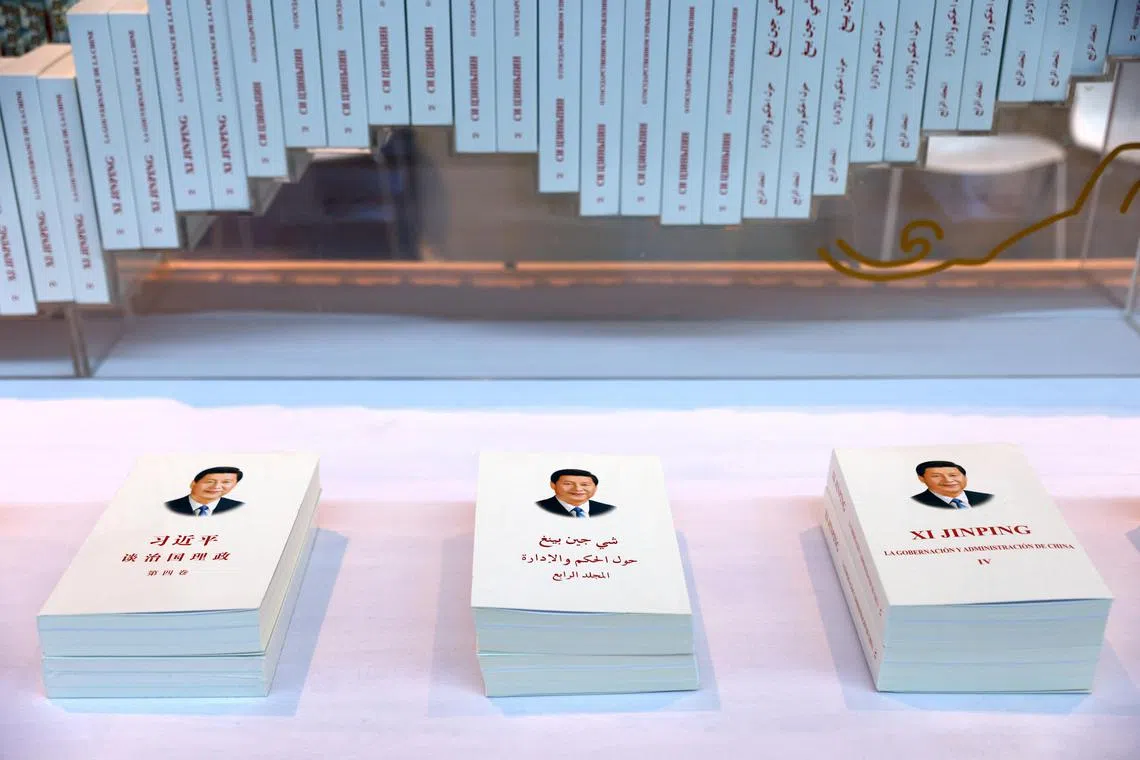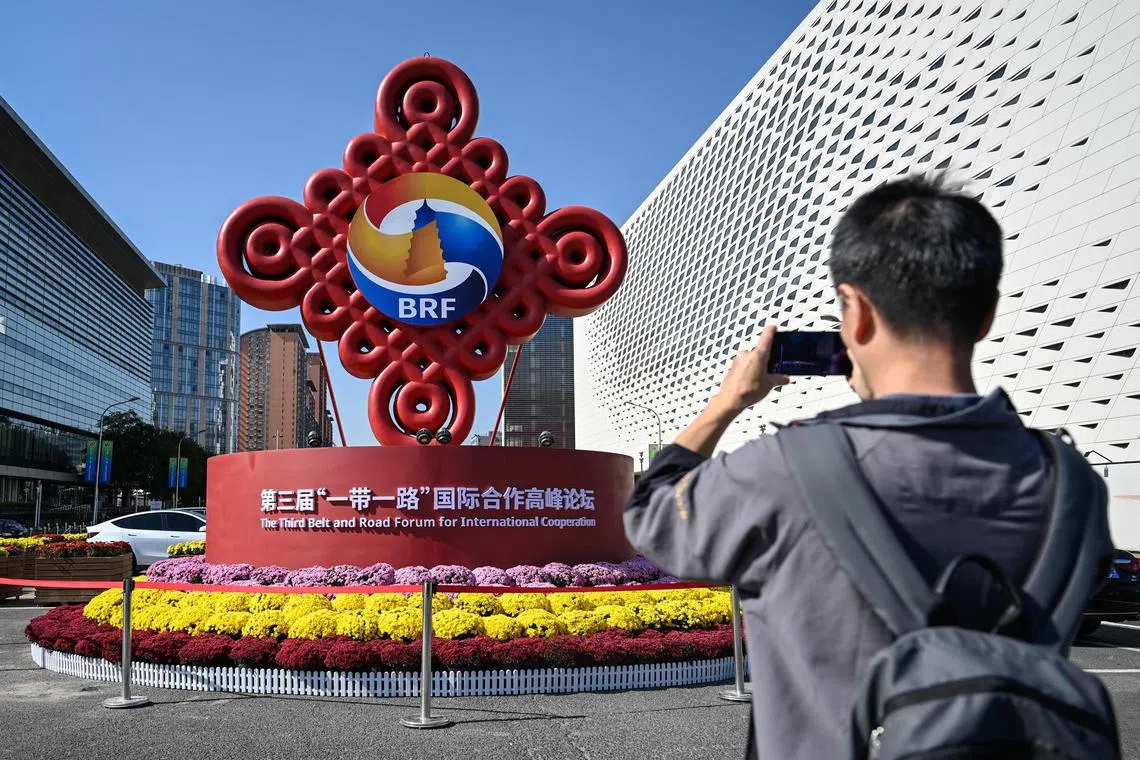Chinese President Xi’s $1.3t ‘project of the century’ faces uncertain future
Sign up now: Get insights on Asia's fast-moving developments

Copies of “Xi Jinping: The Governance of China” in Arabic and Spanish being displayed outside the media centre in Beijing on Oct 16.
PHOTO: REUTERS
Follow topic:
BEIJING – When President Xi Jinping first assembled world leaders to map out his vision for expanding Chinese soft power via a web of infrastructure investment in 2017, he called the Belt and Road Initiative (BRI) the “project of the century”.
As the Chinese statesman opens the third Belt and Road Forum this week,
While the project has drawn US$1 trillion (S$1.36 trillion) in its first decade, according to estimates from think-tank Green Finance & Development Centre, momentum has tapered off in recent years.
China’s overall activity in BRI countries is down about 40 per cent from its 2018 peak, as the world’s second-biggest economy slows. Beijing faces accusations of being an irresponsible lender, driving countries to default.
Fractured ties with the United States have made association with Mr Xi’s pet project increasingly divisive. Italy, its sole Group of Seven member, is set to exit by the end of 2023.
One Chinese official considered the BRI dead, dealt twin blows by Covid-19 and China’s economic problems
The US has assessed that the BRI is in deep trouble, according to a senior American official who asked not to be identified to discuss private conversations. Beijing has less capital to lend and pressure is growing to recoup the outstanding money it loaned, the official said.
Mr Xi will have a chance to answer his critics when a host of Global South leaders arrive this week to pledge support for the programme and test Beijing’s bandwidth for new deals.
Leaders including Russian President Vladimir Putin, Indonesian President Joko Widodo and Thai Prime Minister Srettha Thavisin will be at the gathering.
“Xi will invite his best friends and have all these people come together to celebrate,” said Dr Alfred Wu, an associate professor at the National University of Singapore’s Lee Kuan Yew School of Public Policy. “It’s a clear message that China is trying to have its own allies while challenging the US-led world order.”
Pandemic pullback
The outbreak of Covid-19 put the brakes on China’s infrastructure and trade initiative, as a global slowdown imperilled debtors’ ability to repay their loans.
Zambia was the first African country to default during the pandemic in late 2020. It put China, the nation’s largest creditor, in the spotlight.
As other nations, including Ethiopia, Sri Lanka and Pakistan, fell into debt crises, annual engagement under the BRI plummeted to US$63.7 billion in the first year of the global health crisis, according to a study by the Green Finance and Development Centre at Shanghai-based Fudan University.
That figure was down from a peak of more than US$120 billion in 2018.
That pullback has been sustained by geopolitical tensions and domestic problems plaguing China’s economy, which show little sign of abating.
“External shocks, like the Ukraine war and perhaps in the coming weeks, the new war in the Middle East, are deepening debt and inflation burdens,” said Mr Michael Kugelman, director of the South Asia Institute at the Wilson Centre.
China has responded by shifting to so-called “small but beautiful” projects that benefit people’s livelihoods. The state-run People’s Daily in October cited a water plant in Botswana upgraded by a Chinese firm and a technology partnership with a seed company in Costa Rica as examples.
The average BRI investment deal fell by 48 per cent from the 2018 peak to about US$392 million in the first half of 2023, according to the Fudan report. The report tracks both the value of construction projects that are funded by China as well as those that Chinese companies have equity stakes in.
China’s private companies are also becoming more active in a space once dominated by policy banks and state-owned companies, said director of the Griffith Asia Institute Christoph Nedopil Wang, who authored the Fudan study.
That has resulted in some big investments with more focus on global markets than building infrastructure. Chinese company Contemporary Amperex Technology and the Mercedes-Benz Group, for example, plan to invest more than US$7 billion in a plant in Hungary, the biggest single project in a BRI country since it started in 2013.
Yet the BRI has always been loosely defined, with the label often applied to any projects in nations with friendly ties to China.
The strategy’s geographical focus has also evolved in step with Mr Xi’s foreign policy. Saudi Arabia was one of the top three recipients of BRI lending in 2023, according to the Fudan study, as the Chinese leader seeks to expand his influence in the Middle East.
Political problems
Still, Italy has questioned whether Mr Xi’s flagship initiative brings economic benefits at all
“We have exported a load of oranges to China, (China) has tripled its exports to Italy in three years,” Italy’s Defence Minister Guido Crosetto said in July. “Paris, without signing any treaties, in those days sold planes to Beijing for tens of billions.”
After Italy signed an agreement to cooperate on the BRI in 2019, its imports from China accelerated, but that bump was not reciprocated. In 2022, Italian exports to China only rose 5 per cent, lagging behind those of Germany and France – two countries that are not part of the BRI.
China’s Foreign Ministry has not announced plans for a leaders’ roundtable that Mr Xi hosted at the two previous events, as the summit looks set to attract a smaller crowd of world leaders.
Spurred spending
For Global South nations, Mr Xi’s efforts to pitch his country as a leader of the developing world has been a vital source of funding.
China extended US$114 billion in development financing to Africa alone from 2013 to 2021, according to a study by Boston University.
That spending spurred the US and European governments to expand engagement with some developing nations to counter China’s influence. But while Western rivals have pledged billions of dollars, many of their projects have been slow to get off the ground.

An installation of the Belt and Road Forum in Beijing on Oct 16.
PHOTO: AFP
China’s credit lines will be tested this week when Kenya’s President William Ruto is expected to ask for US$1 billion to finance stalled infrastructure projects. Mr Wu Peng, department director of African affairs at China’s Foreign Ministry, said in October that a “big loan” for a new railway project in Africa will be announced soon.
That will not be enough to reverse the overall trend of a downsized BRI, but may signal Mr Xi’s ongoing commitment to the programme as a linchpin of his foreign policy.
Even with the slower pace of investment, Mr Xi’s imprint means the BRI will not fade away, according to Mr Raffaello Pantucci, a senior fellow at the S. Rajaratnam School of International Studies in Singapore.
“Xi being associated with it so closely means it’s going to stay an important and relevant thing for as long as he stays in power,” Mr Pantucci said. The pace, he added, was probably “too fast at the beginning anyway”. Bloomberg

